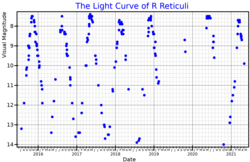R Reticuli
| Observation data Epoch J2000 Equinox J2000 | |
|---|---|
| Constellation | Reticulum |
| Right ascension | 04h 33m 32.83070s[2] |
| Declination | −63° 01′ 44.9951″[2] |
| Apparent magnitude (V) | 9.23[3] (6.35 – 14.2)[4] |
| Characteristics | |
| Evolutionary stage | AGB[5] |
| Spectral type | M4e - M7.5e[6] |
| B−V color index | 1.099±0.045[3] |
| Variable type | Mira[6] |
| Astrometry | |
| Radial velocity (Rv) | 26.0±4.6[3] km/s |
| Proper motion (μ) | RA: +12.111[2] mas/yr Dec.: +16.384[2] mas/yr |
| Parallax (π) | 1.3622 ± 0.0492 mas[2] |
| Distance | 2,390 ± 90 ly (730 ± 30 pc) |
| Details | |
| Mass | 0.88+0.04 −0[7] M☉ |
| Radius | 249+21 −34[8] R☉ |
| Luminosity | 7,571±1,671[8] L☉ |
| Surface gravity (log g) | −0.445[7] cgs |
| Temperature | 3,410+264 −131[8] K |
| Metallicity [Fe/H] | 0.55[7] dex |
| Other designations | |
| Database references | |
| SIMBAD | data |
R Reticuli, also listed under the duplicate variable star designation S Reticuli,[4] is a Mira variable star in the southern constellation Reticulum. It is an aging red giant star on the asymptotic giant branch[5] with a stellar classification that varies between M4e to M7.5e,[6] being hottest near maximum visual magnitude.[10] The brightness of the star varies between apparent visual magnitudes 6.35 and 14.2[4] with an average period of 281.08±0.58 d.[11] The mean maximum magnitude is 7.57 and the mean minimum magnitude 13.80.[11]
References
- ^ "Download Data". aavso.org. AAVSO. Retrieved 1 October 2021.
- ^ a b c d e Vallenari, A.; et al. (Gaia collaboration) (2023). "Gaia Data Release 3. Summary of the content and survey properties". Astronomy and Astrophysics. 674: A1. arXiv:2208.00211. Bibcode:2023A&A...674A...1G. doi:10.1051/0004-6361/202243940. S2CID 244398875. Gaia DR3 record for this source at VizieR.
- ^ a b c Anderson, E.; Francis, Ch. (2012). "XHIP: An extended hipparcos compilation". Astronomy Letters. 38 (5): 331. arXiv:1108.4971. Bibcode:2012AstL...38..331A. doi:10.1134/S1063773712050015. S2CID 119257644.
- ^ a b c VSX; Otero, S. A. (28 January 2011). "R Reticuli". AAVSO Website. American Association of Variable Star Observers. Retrieved 25 May 2014.
- ^ a b Whitelock, Patricia A.; et al. (May 2008). "AGB variables and the Mira period-luminosity relation". Monthly Notices of the Royal Astronomical Society. 386 (1): 313–323. arXiv:0801.4465. Bibcode:2008MNRAS.386..313W. doi:10.1111/j.1365-2966.2008.13032.x. S2CID 17676993.
- ^ a b c Samus, N. N.; et al. (2017). "General Catalogue of Variable Stars". Astronomy Reports. 5.1. 61 (1): 80–88. Bibcode:2017ARep...61...80S. doi:10.1134/S1063772917010085. S2CID 125853869.
- ^ a b c Anders, F.; Khalatyan, A.; Chiappini, C.; Queiroz, A. B.; Santiago, B. X.; Jordi, C.; Girardi, L.; Brown, A. G. A.; Matijevič, G.; Monari, G.; Cantat-Gaudin, T.; Weiler, M.; Khan, S.; Miglio, A.; Carrillo, I.; Romero-Gómez, M.; Minchev, I.; De Jong, R. S.; Antoja, T.; Ramos, P.; Steinmetz, M.; Enke, H. (2019). "Photo-astrometric distances, extinctions, and astrophysical parameters for Gaia DR2 stars brighter than G = 18". Astronomy and Astrophysics. 628: A94. arXiv:1904.11302. Bibcode:2019A&A...628A..94A. doi:10.1051/0004-6361/201935765. S2CID 131780028.
- ^ a b c Brown, A. G. A.; et al. (Gaia collaboration) (August 2018). "Gaia Data Release 2: Summary of the contents and survey properties". Astronomy & Astrophysics. 616. A1. arXiv:1804.09365. Bibcode:2018A&A...616A...1G. doi:10.1051/0004-6361/201833051. Gaia DR2 record for this source at VizieR.
- ^ "R Ret". SIMBAD. Centre de données astronomiques de Strasbourg. Retrieved 2020-11-18.
- ^ Skiff, B. A. (2014). "VizieR Online Data Catalog: Catalogue of Stellar Spectral Classifications (Skiff, 2009- )". VizieR On-line Data Catalog. Bibcode:2014yCat....1.2023S.
- ^ a b Vogt, N.; et al. (November 2016). "Determination of Pulsation Periods and Other Parameters of 2875 Stars Classified as MIRA in the All Sky Automated Survey (ASAS)". The Astrophysical Journal Supplement Series. 227 (1): 13. arXiv:1609.05246. Bibcode:2016ApJS..227....6V. doi:10.3847/0067-0049/227/1/6. S2CID 119295645. 6.

